Real estate SEO can be problematic and challenging. You’re not just competing with other brokers and Realtors — you’re competing with sites like Zillow, Trulia and HomeFinder.com.
Add to that, most brokers find themselves stuck with a clunky website management system that publishes the same IDX listings everyone else does.
Why is Google going to show your site over the rest?
Fortunately this guide will highlight some best practices you can implement to start getting more leads for your real estate business.
How To Set Up Your Real Estate Website The Right Way
It all starts with your website.
Your website is the most important piece of real estate you have (excuse the pun). Even if you have a physical location, your website is often where people find you first or visit to get more information before contacting you.
Here’s what you need to pay attention to when designing your real estate website.
1. Use a strong call-to-action that speak directly to your ideal client.
As a general rule, you have about 3 seconds to grab someone’s attention when they visit your website. Miss the mark there and your visitor is as good as gone, but hook them with the promise of gain or the loss of scarcity and you may just win a conversion.
The short of it — sell benefits.
Let’s look at an example.
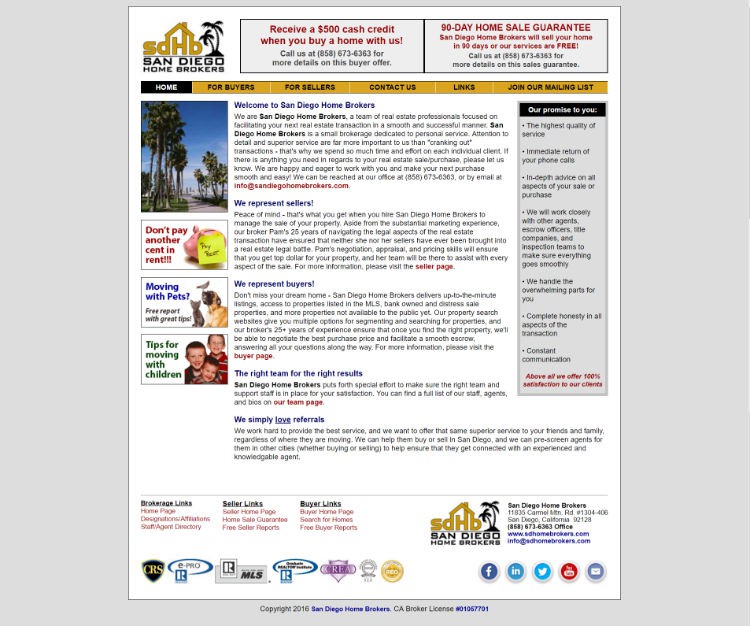
I’m the type that would rather have the good news upfront, so let’s talk about what they got right.
The GOOD:
- Guarantee and offer placed prominently on the page.
- Contact information above the fold and on the bottom of the page.
- Good use of trust badges.
The BAD:
- Information overload. Too many options leaves people confused on what to do next.
- No lead form or easy way to get in touch.
Here is what you get when you adhere to landing page best practices:
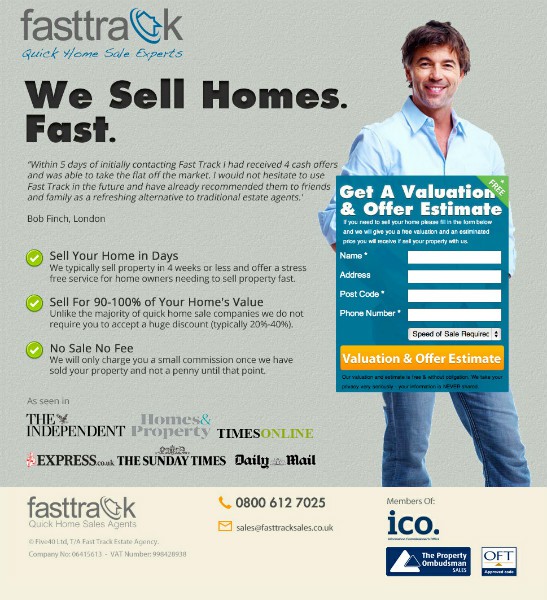
Here’s the breakdown of what they did:
- Strong benefits-driven statement (i.e. “We Sell Homes. Fast.”)
- Testimonial and social proof above the fold
- Strong call-to-action and lead form
- Bullet points that drive home more benefits
- Ample use of trust badges and accreditations
- Contact information on page
When you create your landing page, remember these 3 things:
- Communicate exactly what you are offering, focusing on benefits
- Add more context to explain how you can help solve their problem
- A simple invite that pushes the visitor to take the next step
The most important thing you can offer a website visitor is a clear next step towards solving their problem.
2. Have great site architecture that funnels your visitor to the right place.
User experience is more than a buzzword. People want information right away. A confusing website is the quickest way to make someone hit the back button.
Good site architecture is also good for real estate SEO. If your site is easy to navigate, it’s easy for Google to index your content — which means a better shot at higher rankings.
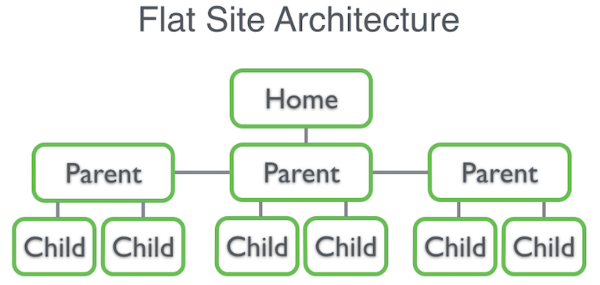
When planning out the content of your real estate website, it’s best to think of what your core offer is and then build out topic clusters, or closely related content, to support the main theme. Organizing your content this way builds more depth around your target keywords, which increases keyword density and helps Google understand your website better.
The added benefit of this is you are able to generate content ideas rather quickly, so you’re not wasting time thinking about what you should write on next.
There are plenty of free SEO tools that help you do this.

Answer The Public is a great tool to build topic clusters from your keyword research. Google loves content depth, so the more content you have centered around a specific topic the better.
3. Make sure your website is mobile-friendly.
As a real estate professional you probably spend a lot of time on your phone. It goes with the territory, but across the board more and more people are using mobile phones over desktop.
Responsive design allows your website to scale to any device, so it can easily be viewed on smartphones and tablets. Google strongly advises having a mobile-friendly website as it is a strong ranking signal. Sites that are not mobile-friendly have less visibility in mobile search.
You can check if your website is mobile using Google’s Mobile-Friendly Test.
4. Embrace local search and schema markup.
HomeFinder.com, Trulia and Zillow all focus on local. Whatever area you operate in you need to put all your effort into ranking for local terms.
The chances of your website ranking #1 for “homes for sale” or “real estate for sale” on a national level is pretty close to zero. There is just too much demand for those terms and you’re competing with sites that have millions of pages indexed in Google.
But none of this matters if your target market is in the area you serve.
Want more exposure in Google for your real estate website? Follow these rules:
#1 — Use NAP on your website. “NAP” stands for name, address and phone number. You want to make sure your address is listed the same way on your website as it is on local directory sites. This is the first step to any local SEO effort.
You also want to include Schema.org markup on your web page. Schema helps search engines understand your website better and allows them to display rich snippets of information in the search results page.

This post from KISSmetrics breaks down the steps in detail. If you’re not the technical type, you can also use a schema generator to grab the code or a WordPress plugin (if you use WP).
#2 — Claim your Google Local Business Listing. This is a must for anyone who wants local exposure. By now I’m sure you’re familiar with the local search results:
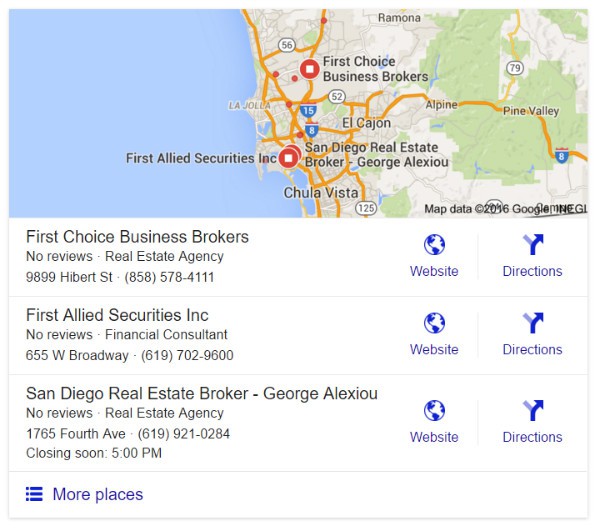
Google’s local listings actually present a great advantage. Any business can get listed and if you optimize your listing correctly you can bypass a lot of link building and shoot right to the first page of Google.
The first step is claiming your listing or creating one. Google will verify your business location by sending a postcard with a verification number on it.
To complete your page, you should also add the following:
- Logo
- Images (pictures of your business or current listings)
- Videos (home walkthroughs, welcome video, etc)
- Contact information
Next, you’ll want to complete your About page. The good thing about this page is you can add links, so it’s a good practice to include links back to important pages on your site.
5. Install Google Tag Manager and Google Analytics.
“What gets measured, gets managed.”
That statement is as true today as was when Peter Drucker first said it. I would argue it’s even more important today, especially if you are investing in SEO or spending money on ads.
There are so many free tools available to get actionable data that it is foolish not to be measuring what’s happening with your website.
Google Analytics will help you:
- See how many visitors you get each day/week/month
- See what pages on your website are most popular
- See get the most organic traffic from Google
- Measure conversions and conversion rate
There are a ton more ways you can slice and dice the data, but the most important thing is once you have G.A. set up correctly you can accurately see how effective your marketing really is.
6. Set up Custom Audiences for Adwords and Facebook.
Emails, phone calls, meetings — the list goes on.
Every sales process requires a series of “touches”. Each interaction helps build rapport. Familiarity builds trust, and that’s what you’re after.
Staying top of mind is extremely important and remarketing to the people who have already expressed interest (by visiting your site) helps you seem everywhere at once and keeps you top of mind.
Adwords and Facebook allow you to set up Custom Audiences based on the people that visit your website. This will allow you to retarget them later through Google Adwords or on Facebook.
Here’s how it works: When someone visits a page on your website a pixel on your website tracks the visit and adds that person to your ad account.
For example, if you work with both buyers and sellers, you would have custom audiences based on the different pages on your website. This allows you to show the right ads to the right people. And because you are showing ads to people who have already found you, the cost to show these ads is greatly reduced.
I’m sure you’ve seen this in action. Just go to Amazon, look at a few items and start browsing other websites. Chances are you’ll start seeing ads that match up to what you were just looking at. You can easily do the same thing to your own prospects to gently remind them how you can help them.
7. Automate follow-up and nurture leads on autopilot.
A big part of being a real estate professional is building relationships and communicating. Undoubtedly, you end up answering the same questions, the same objections, and having the same conversation with different people.
It would be foolish to think you can eliminate this part of the job, but what you can do is create an email campaign built around the questions and objections of your ideal clients.
You can automate the entire process using Mailchimp or Aweber.
While you might think creating an email autoresponder series is difficult, you probably already have all the information you need. Jot down the common questions/objections you deal with and then grab content from your website.
I would recommend a simple 3-part email series:
Email #1 — Welcome Email.
Selling is all about establishing trust. We’ve talked about it before, but it’s insanely important when you are dealing in high dollar transactions like real estate. One of the best ways you can stand out from the competition is by creating a quick welcome video to send your prospects after they fill out your form.
Imagine if you were looking for a new home and after you requested more info, you an email landed in your box that looked like this:
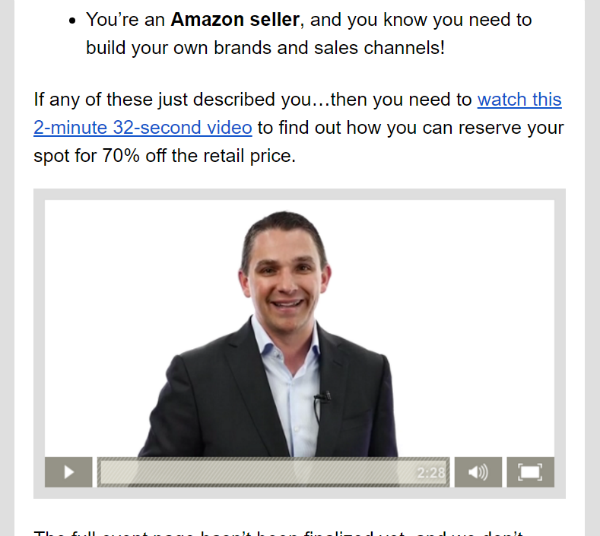
I have to point out a couple things… 1) this is an email from DigitalMarketer.com, not a real estate email… and 2) videos cannot be embedded in an email.
That being said, you can hack it by taking a screenshot of your video and putting that image in your email. You can also upload to YouTube and attach that link, which attaches videos in Gmail and makes it to where you can click and watch from there.
I would actually NOT attach the video. You’ll lose out on Custom Audience data by having them not click over to your page. Instead, I would embed the video on a special landing page on my website and link the image of the video in the email to that page.
You don’t have to overthink this either and there’s no need to create an overtop video. Get yourself in a good location, dress as you would present yourself to clients and record right from your phone. Take a few minutes to introduce yourself and let your prospect know that you’ll be sending them some more information over the next few days, but if they’d like to get in touch just give you a call or send a text.
Email #2 — FAQ Email.
The next email you would send out the very next day. This email should link to a page on your website that lists frequently asked questions. Very straightforward. Close out the email by reminding them that they can contact you anytime.
Email #3 — Appointment Email.
The last email you would send in the series would be to push them towards making an appointment. Ideally, you would have a link that would use an app that would allow them to schedule an appointment. This cuts down on the back and forth emails and helps you set more appointments faster. Calendly is a great app for this and it syncs with Google Calendar.
Learn more about how our SEO services help you get higher Google rankings without paying upfront.








